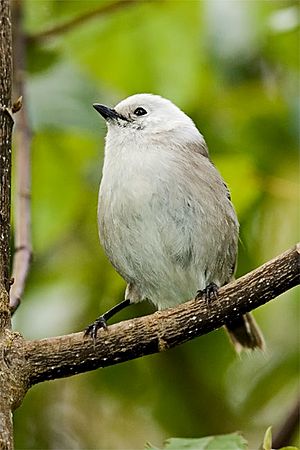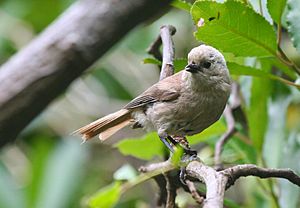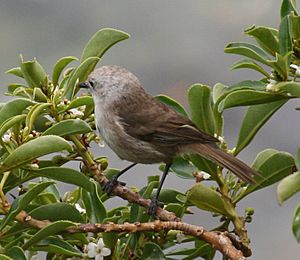Whitehead (bird) facts for kids
Quick facts for kids Whitehead |
|
|---|---|
 |
|
| Conservation status | |
| Scientific classification | |
| Genus: |
Mohoua
|
| Species: |
albicilla
|
The whitehead (Mohoua albicilla), also called pōpokotea in Māori, is a small bird found only in New Zealand. It is about 15 centimeters long and weighs around 18.5 grams. This bird belongs to a special family called Mohouidae.
Male whiteheads have pale brown backs, wings, and tails. Their heads and undersides are a very pure white. Females and young birds look similar, but their necks and the tops of their heads are a bit brownish. Their black beaks and eyes stand out against their white heads, and their feet are bluish-black.
Whiteheads used to be common in New Zealand's native forests. However, their numbers have dropped a lot since Europeans arrived. Today, they live in only a small part of their original home. In the past, forests were cut down, destroying their homes. Now, the biggest danger comes from animals like rats and stoats that were brought to New Zealand. People are working hard to protect whiteheads. They have even been moved to new safe areas near Auckland and Wellington.
Long ago, whiteheads were very important in Māori culture. They appeared in many stories and were seen as messengers from the gods. Māori people also believed whiteheads could predict the future. Because of this, live whiteheads were sometimes used in special ceremonies.
Contents
Where Whiteheads Live
Whiteheads have always lived only on the North Island of New Zealand and some islands nearby. These islands include Little Barrier Island, Great Barrier Island, and Kapiti Island. On Little Barrier Island, whiteheads are the most common forest bird. However, their living areas have shrunk a lot since the 1800s because of human activities.
The whitehead's close relative, the yellowhead, lives only on the South Island. Whiteheads usually live in large areas of old native forest and scrub. But they are also smart and have started living in some pine tree farms, especially in the middle of the North Island.
Whitehead Habits and Life
Whiteheads often fly together in groups. These groups are usually made up of small family units.
What Whiteheads Eat
Whiteheads mainly eat insects. They are known as tree-dwelling insect eaters. They mostly hunt for spiders, moths, caterpillars, and beetles. They find these insects on tree trunks, leaves, and branches high up in the trees. They rarely look for food on the ground.
Sometimes, they also eat fruits from native plants like māhoe and matipo. Just like the yellowhead, whiteheads often hang upside down from branches while they are eating. Whiteheads sometimes join other birds like saddlebacks, kākāriki, or silvereyes. They do this to catch insects that these other birds might shake loose while feeding.
Whitehead Reproduction
Unlike yellowheads, which only nest inside tree holes, whiteheads build a more common cup-shaped nest. They build their nests between 1 and 15 meters above the ground. They can build them high in the forest canopy or lower down in smaller trees or bushes.
Female whiteheads lay 2 to 4 eggs, which can be different colors. The eggs hatch after about 18 days. The young birds stay in the nest for another 16 to 19 days, and both parents feed them. In November and December, a bird called the Pacific long-tailed cuckoo sometimes lays its egg in a whitehead's nest. The cuckoo pushes the whitehead's eggs out and lays its own single egg.
Whiteheads and People
Whiteheads in Māori Culture and Legends
In the past, the whitehead was a very special bird in Māori culture. It appeared in many Māori stories and was used in special ceremonies. Flocks of whiteheads are part of the hākuturi, which are many small birds known as "The myriads of Hākuturi." These birds are believed to be the spirit guardians of the forest.
In one story, a hero named Rata cut down a tree to make a canoe. But he forgot to ask for permission from Tāne, the god of the forest. Whiteheads and riflemen chirped loudly at him to tell him off. They then gathered the pieces of the tree until it was whole again. This happened many times until Rata felt sorry. Then the birds helped him cut the tree and make the canoe.
In some stories, the whitehead was one of the small birds chosen by Māui. He wanted to end death by fighting Hine-nui-te-pō, the goddess of night and death. Whiteheads sometimes swarm and attack things. This behavior is seen in a legend where swarms of whiteheads scratched out the eyes of Whaitiri, the goddess of thunder, making her blind.
The whitehead was a very tapu (sacred) bird. It was seen as a messenger between people and the gods. This was shown in a ritual called the tohi rite for babies. A priest called a tohunga would touch a baby's head with a live whitehead. He would then say a karakia (chant). This was to bring the mana (power) of the gods to the child. It also helped the child learn the knowledge of their ancestors. After the chant, the bird was set free. This showed that the mana would return to the gods when the child died.
Whiteheads also acted as messengers to the gods when a new pā (fortified village) was opened. After the ceremonies, a single whitehead was released unharmed. This made the pā safe to enter. This ritual was meant to bring good luck and strength to the pā and its people.
If someone wanted to become a matakite, or seer (someone who can see the future), they first had to catch a small bird like a whitehead. After more rituals, the person would sleep in a hut with the bird for a night. The next morning, if the bird flew away by itself, it meant the person was suitable to be a seer, just as the whitehead was believed to be. In the past, if a flock of whiteheads appeared, Māori people from the Whanganui River area believed it meant that kēhua (ghosts) were nearby.
Whiteheads in New Zealand Culture
In the 1800s, forest workers in New Zealand thought whiteheads were good at predicting the weather. They would chirp loudly for hours before a storm was coming. Forest workers always paid attention to this warning. Early European settlers called this bird "Joey whitehead" because of its white head. This is how the bird got its English name.
Dangers and Conservation
Fossil remains show that whiteheads lived on the North Island long ago. They were still very common when Europeans started settling in New Zealand in the 1840s. However, soon after, their numbers began to drop. This happened because large areas of lowland forests were cleared for farming. Also, new animals brought by Europeans, like rats and stoats, hunted the whiteheads.
These introduced animals are still a problem for many whitehead groups today. They compete with whiteheads for food and also hunt them. Because of this, whiteheads have disappeared from many areas on the North Island, especially in the north. They vanished from Northland in the 1870s and from the greater Auckland area in the 1880s. They also disappeared from Great Barrier Island in the 1950s.
To help bring whiteheads back to their old homes, many conservation groups have released them into new areas over the last twenty years. These releases are part of bigger projects to restore native forests.
| Release location | Birds sourced from | Number of whiteheads released | Date(s) of release | Population successfully established? |
|---|---|---|---|---|
| Mana Island | Kapiti Island | 38 | 20 July 2010 | Uncertain |
| Waitākere Ranges | Tiritiri Matangi Island | 55 | August 2004 | Uncertain |
| Hunua Ranges | Tiritiri Matangi Island | 40 | April 2003 | Yes |
| Karori Wildlife Sanctuary | Kapiti Island | 63 | 2001–2002 | Yes |
| Tiritiri Matangi Island | Little Barrier Island | 80 | 1989–1990 | Yes |
Until recently, whiteheads were gone from the North Island mainland north of Hamilton. But this has changed thanks to three releases in the Hunua Ranges, Waitākere Ranges, and on Tiritiri Matangi Island. The releases at Karori and Tiritiri Matangi were done by different groups. The Hunua release was an idea from the Auckland Regional Council. The Auckland Regional Council also helped with the Waitākere Ranges "Ark in the Park" project. This project is a team effort between the local government and a conservation group called Forest and Bird.
Images for kids
See also
 In Spanish: Mohoua cabeciblanco para niños
In Spanish: Mohoua cabeciblanco para niños





